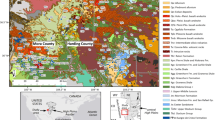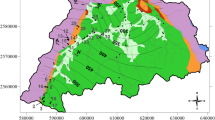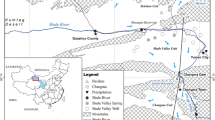Abstract
Identification of hydrogeologic controls on groundwater flowpaths, recharge, and salinization is often critical to the management of limited arid groundwater resources. One approach to identifying these mechanisms is a combined analysis of hydrogeologic and hydrochemical data to develop a comprehensive conceptual model of a groundwater basin. To demonstrate this technique, water samples were collected from 33 discrete vertical zone test holes in the Hueco Bolson aquifer, located within the Trans-Pecos Texas region and the primary water resource for El Paso, Texas, USA and Juárez, Mexico. These samples were analyzed for a suite of geochemical tracers and the data evaluated in light of basin hydrogeology. On the basis of δ2H and δ18O data, two regional recharge sources were recognized, one originating from western mountain-fronts and one from through-flow of the adjacent Tularosa aquifer. Chloride concentrations were strongly correlated with lithologic formations and both Cl/Br and 36Cl ratios suggested the primary chloride source is halite dissolution within a specific lithologic unit. In contrast, sulfur isotopes indicated that most sulfate originates from Tularosa basin Permian gypsum sources. These results yielded a more comprehensive conceptual model of the basin, which suggested that chloride salinization of wells is the result of upconing of waters from the Fort Hancock formation.
Résumé
L’identification des contrôles hydrogéologiques sur les écoulements, la réalimentation et la salinisation est fréquemmement critique pour la gestion des faibles ressources en eau souterraine des zones arides. Une des approches pour identifier ces mécanismes consiste à combiner l’analyse des données hydrogéologiques et hydrochimiques pour développer un modèle conceptuel exhaustif sur un bassin hydrogéologique. Afin de mettre en application cette technique, des échantillons d’eau ont été prélevés sur 33 sondages permettant une discrimination verticale, dans l’aquifère de Hueco Bolson, dans la région texane de Trans-Pecos, qui constitue la ressource principale pour El Paso (Texas, Etats-Unis) et Juárez (Mexique). Plusieurs traceurs géochimiques ont été analysés, et les données ont été étudiées sur la base des connaissances hydrogéologiques du bassin. Les données de δ2H et δ18O ont permis d’identifier deux sources d’alimentation régionales : une première sur les contreforts des montagnes de l’ouest, et une seconde par drainance à travers l’aquifère adjacent de Tularosa. Les concentrations en chlorures étaient étroitement corrélées à la lithologie, et les rapports Cl/Br et 36Cl ont suggéré que la source primaire des ions chlorures est la dissolution de la halite dans une unité lithologique spécifique. Par contre, les isotopes du soufre ont indiqué que la majorité des sulfates proviennent du gypse du Bassin permien de Tularosa. Ces résultats conduisent à un modèle conceptuel plus exhaustif, qui suggère que la salinisation chlorurée des puits résulte d’un flux d’eau ascendant depuis la formation de Fort Hancock.
Resumen
La identificación de los factores hidrogeológicos que controlan el flujo, recarga y salinización del agua subterránea es crítica para el manejo de este recurso en regiones áridas. Una forma de identificar estos factores es el análisis combinado de datos hidrogeológicos e hidroquímicos para desarrollar un modelo conceptual exhaustivo de la cuenca. Para demostrar esta técnica, muestras de agua fueron tomadas de 33 pozos de prueba en zona vertical en el acuífero Hueco Bolson, localizado en la región de Trans-Pecos, Texas y la principal fuente de agua de El Paso, Texas, USA y Ciudad Juárez, México. En estas muestras, se analizó un grupo de trazadores geoquímicos y los datos fueron evaluados a la luz de hidrogeología de cuenca. Con base en datos de δ2H y δ18O, dos fuentes de recarga regional fueron identificadas, una originada en las montañas del oeste y otra proveniente del flujo que atraviesa al adyacente acuífero Tularosa. Las concentraciones de cloruro se correlacionaron fuertemente con las formaciones litológicas y ambos cocientes Cl/Br y 36Cl sugirieron que la fuente primaria de cloruro es la disolución de halita dentro de una unidad litológica específica. En contraste, isótopos de azufre indicaron que la mayoría del sulfato se origina en fuentes de yeso de la cuenca Permiana de Tularosa. Estos resultados produjeron un modelo conceptual más exhaustivo de la cuenca, el cual sugiere que la salinización de cloruro de los pozos es el resultado de aguas que emergen a los pozos desde la formación Fort Hancock.











Similar content being viewed by others
References
Alley WM, Leake SA (2004) The journey from safe yield to sustainability. Ground Water 42(1):12–16
Anderholm SK, Heywood CE (2003) Chemistry and age of ground water in the southwestern Hueco Bolson, New Mexico and Texas. US Geol Surv Water Resour Invest Rep 02–4237, 16 pp
Ashworth JB (1990) Evaluation of ground-water resources in El Paso County, Texas. Texas Water Development Board Report 324, TWDB, Austin, TX, 25 pp
Banner JL, Wasserburg GJ, Dobson PF, Carpenter AB, Moore CH (1989) Isotopic and trace element constraints on the origin and evolution of saline groundwaters from central Missouri. Geochim Cosmochim Acta 53:383–398
Barnes MA, Anthony EY, Williams I, Asquith GB (2002) Architecture of a 1.38 Ga granite-rhyolite complex as revealed by geochronology and isotopic and elemental geochemistry of subsurface samples from west Texas, USA. Precambrian Res 119:9–43
Clark ID, Fritz P (1997) Environmental isotopes in hydrogeology. Lewis, Boca Raton, FL, 328 pp
Coplen TB (1995) Reporting of stable carbon, hydrogen and oxygen abundances. International Atomic Energy Agency, IAEA Tecdoc 825, IAEA, Vienna, pp 31–34
Cook PG, Herczeg AL (eds) (2000) Environmental tracers in subsurface hydrology, 2nd printing. Kluwer, Boston
Craig H (1957) Isotopic standards for carbon and oxygen and correction factors for mass-spectrometric analysis of carbon dioxide. Geochim Cosmochim Acta 12:133–149
Darling BK (1997) Delineation of the ground-water flow systems of the Eagle Flat and Red Light Basins of Trans-Pecos, Texas. PhD Thesis, The University of Texas at Austin, USA, 179 pp
Davis SN, Whittemore DO, Fabryka-Martin J (1998) Uses of chloride/bromide ratios in studies of potable water. Ground Water 36(2):338–350
Davis SN, Fabryka-Martin JT, Wolfsberg LE (2004) Variations of bromide in potable groundwater in the United States. Ground Water 42(6):902–909
Dickinson WR (1999) Geologic framework of the Catalina foothills, outskirts of Tucson (Pima County, Arizona). Arizona Geological Survey Contributed Map CM-99-B, AGS, Phoenix, AZ, 31 pp
Eastoe CJ, Hibbs BJ (2005) Stable and radiogenic isotope evidence relating to regional groundwater flow systems originating in the high Sacramento Mountains, New Mexico. Presented at the 2005 annual Fall AGU meeting, San Francisco, CA, 5–9 December 2005
Eastoe CJ, Hibbs BJ, Olivas AG, Hogan JF, Hawley J, Hutchison WR (2007) Isotopes in the Hueco Bolson Aquifer, Texas (USA) and Chihuahua (Mexico): Local and general implications for recharge sources in alluvial basins. Hydrogeol J (in press)
Faure G (1986) Principles of isotope geology, 2nd edn. Wiley, Hoboken, NJ, 589 pp
Fisher RS, Mullican WF (1990) Integration of ground-water and vadose-zone geochemistry to investigate hydrochemical evolution: a case study in arid lands of the northern Chihuahuan Desert, Trans-Pecos Texas. University of Texas at Austin, Bureau of Economic Geology, Geol Circ 90–5
Gates JS, White DE, Stanley WD, Ackerman HD (1978) Availability of fresh and slightly saline groundwater in the basins of westernmost Texas. US Geol Surv Open-File Rep 78–663, 115 pp
Gaye CB (2001) Isotope techniques for monitoring groundwater salinization. Hydrogeol J 9(3):217–218
Gehre M, Hoefling R, Kowski P, Strauch G (1996) Sample preparation device for quantitative hydrogen isotope analysis using chromium metal. Anal Chem 68:4414–4417
Gonfiantini R (1978) Standards for stable isotope measurements in natural compounds. Nature 271:534–536
Gu A (2005) Stable isotope geochemistry of sulfate in groundwater of southern Arizona: implications for groundwater flow, sulfate sources, and environmental significance. PhD Thesis, University of Arizona, USA
Hanor JS (1994) Origin of saline fluids in sedimentary basins. In: Parnell J (ed) Geofluids: origin, migration and Evolution of fluids in sedimentary basins. Geol Soc Spec Publ 78:151–174
Harter T (2003) Water well design and construction. Publication 8086, University of California Division of Agriculture and Natural Resources, Davis, CA
Hawley JW, Kernodle JM (2000) Overview of the hydrogeology and geohydrology of the northern Rio Grande basin-Colorado, New Mexico, and Texas: In: Ortega-Klett CT (ed) Proceedings of the 44th Annual New Mexico Water Conference. New Mexico Water Resources Research Institute Report 312, Water Resources Research Institute, Las Cruces, NM, pp 79–102
Herczeg AL, Simpson JH, Mazor E (1993) Transport of soluble salts in a large semiarid basin: River Murray, Australia. J Hydrol 144:59–84
Heywood CW, Yager RM (2003) Simulated ground-water flow in the Hueco Bolson, an alluvial-basin aquifer system near El Paso, Texas. US Geol Surv Water Resour Invest Rep 02–4108, 73 pp
Hibbs BJ (1999) Hydrogeologic and water quality issues along the El Paso/Juarez Corridor: an international case study. Environ Eng Geosci 5:27–39
Hibbs BJ, Boghici RN, Hayes ME, Ashworth JB, Hanson AT, Samani ZA, Kennedy JF, Creel BJ (1997) Transboundary aquifers of the El Paso/Ciudad Juarez/Las Cruces region. Texas Water Development Board and New Mexico Water Resources Research Institute, technical contract nos. X 996343-01-0 and X 996350-01-0, USEPA, Washington, DC, 145 pp
Hibbs B, Phillips F, Hogan J, Eastoe C, Hawley J, Kennedy J, Nuñez F, Granados A, Kretzschmar T (2003) Binational study of the surface and ground water resources of the El Paso/Juárez International Corridor. In: Rubin K (ed) Trans-boundary water issues. Water Resources Update. Issue No. 125:25–30, The Universities Council on Water Resources, Carbondale, Il, USA
Hutchison WR (2006) Groundwater management in El Paso, Texas. Dissertation.com, Boca Raton, FL
Kharaka YK, Hanor JS (2004) Deep fluids in the continents: I. sedimentary basins. In: Holland HD, Turekian KK (eds) Treatise on geochemistry, vol 5: surface and ground water, weathering and soils. Elsevier, Boston, pp 499–539
Langford RP (2001) Segmentation of the Rio Grande alluvial surface and evolution of the Rio Grand rift. In: Proceedings of the 53rd Annual Meeting of the Rocky Mountain Section of the Geological Society of America, Boulder, CO, USA
Lee CH (1915) The determination of safe yield of underground reservoirs of the closed basin type. Trans Am Soc Civil Eng 78:148–251
Mack GH, Seager WR (1990) Tectonic controls on facies distribution of the Camp Rice and Palomas Formations (Pliocene-Pleistocene) in the southern Rio Grande rift. Geol Soc Am Bull 102:45–53
Meyer WR (1976) Digital model for simulated effects of ground-water pumping in the Hueco Bolson, El Paso area, Texas, New Mexico, and Mexico. US Geol Surv Water Resour Invest Rep 58–75:1–31
National Oceanic and Atmospheric Administration (NOAA) (2005) Climate Data. http://www.noaa.gov/climate.html. Cited 8 August 2005
Phillips FM, Hogan JF, Scanlon BR (2004) Introduction and overview. In: Groundwater recharge in a desert environment: the southwestern United States. Water Science and Application Series, vol. 9. American Geophysical Union, Washington, DC, pp 1–14
Plummer LN, Bexfield LM, Anderholm SK, Sanford WE, Busenberg E (2004) Geochemical characterization of ground-water flow in the Santa Fe Group Aquifer System, Middle Rio Grande Basin, New Mexico. US Geol Surv Water Resour Invest Rep 03–4131
Richter BC, Kreitler CW (1993) Geochemical techniques for identifying sources of ground-water salinization. CRC, Boca Raton, FL, 258 pp
Scanlon BR, Kubik PW, Sharma P, Richter BC, Gove HE (1990) Bomb Chlorine-36 analysis in the characterization of unsaturated flow at a proposed radioactive waste disposal facility, Chihuahuan Desert, Texas. Nucl Instrum Methods Phys Res 52:489–492
Sophocleous M (2000) From safe yield to sustainable development of water resources: the Kansas experience. J Hydrol 235:27–43
Stuart CJ, Willingham DL (1984) Late Tertiary and Quaternary fluvial deposits in the Mesilla and Hueco Bolsons, El Paso area, Texas. Sediment Geol 38:1–20
UN/World Water Assessment Programe (2003) World water development report: water for people, water for life. http://www.unesco.org/water/wwap/wwdr. Cited 29 August 2005
Whittemore DO (1995) Geochemical differentiation of oil and gas brine from other salt water sources contaminating water resources: case studies from Kansas and Oklahoma. Environ Geosci 2:15–31
Wilkins DW (1986) Geohydrology of the southwest alluvial basins, regional aquifer-systems analysis in parts of Colorado, New Mexico, and Texas. US Geol Surv Water Resour Invest Rep 84–4224, 61 pp, plates
Williams JH (2001a) Salt balance in the Rio Grande project from San Marcial, New Mexico, to Fort Quitman, Texas. MSc Thesis, New Mexico State University, Las Cruces, NM
Williams WD (2001b) Anthropogenic salinisation of inland waters. Hydrobiologia 466:329–337
Wilson JL, Guan H (2004) Mountain-block hydrology and mountain-front recharge. In: Hogan JF, Phillips FM, Scanlon BR (eds) Groundwater recharge in a desert environment: the southwestern United States. AGU, Washington, DC, pp 113–137
Witcher JC, King JP, Hawley JW, Kennedy JF, Williams J, Cleary M, Bothern L (2004) Sources of Salinity in the Rio Grande and Mesilla Basin Groundwater. New Mexico Water Resources Research Institute Technical Completion Report No. 330, New Mexico State University, Las Cruces, NM, 183 pp
Acknowledgements
This work is supported by SAHRA (Sustainability of semi-Arid Hydrology and Riparian Areas) at the University of Arizona under the Science and Technology Center (STC) Program of the National Science Foundation, Agreement No. EAR-9876800. This research is based on an existing body of hydrogeochemical knowledge and data developed through association between SAHRA, the Center for Environmental Analysis-Centers of Research Excellence in Science and Technology (CEA-CREST) at California State University, Los Angeles, Universidad Autonoma De Juárez, New Mexico State University, University of Texas at El Paso, and El Paso Water Utilities (Hibbs et al. 2003). This larger project would not exist without the extensive sampling campaigns and collaborative efforts of the El Paso Water Utilities. The present study owes greatly to contributions by the El Paso Water Utilities, regional geologic information provided by J. Hawley of New Mexico State University and assistance in preparation of 36Cl samples by F. Phillips and S. McGee of the New Mexico Institute of Technology.
Author information
Authors and Affiliations
Corresponding author
Rights and permissions
About this article
Cite this article
Druhan, J.L., Hogan, J.F., Eastoe, C.J. et al. Hydrogeologic controls on groundwater recharge and salinization: a geochemical analysis of the northern Hueco Bolson aquifer, Texas, USA. Hydrogeol J 16, 281–296 (2008). https://doi.org/10.1007/s10040-007-0222-9
Received:
Accepted:
Published:
Issue Date:
DOI: https://doi.org/10.1007/s10040-007-0222-9




